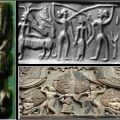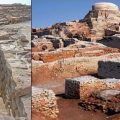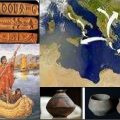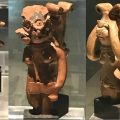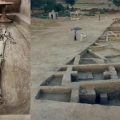Puranic Evidence of Farming in Ancient India; Swastika and Pashupatinath in Indus Valley Seals
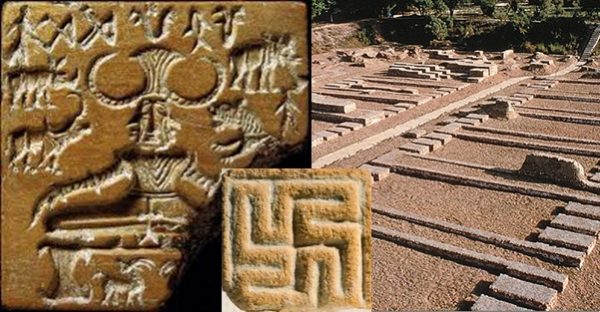
Despite the clear evidence of some Hindu religious and social practices noticed in Indus Valley seals including Pashupatinath, the swastika, and more, Michael Witzel, Wales Professor of Sanskrit, dismisses these as not strong enough to prove the continuity of such practices.
This article is a continuation of an article titled – Aryan Migration Theory False: Proven by Fresh Research on Indus Valley Sites.
Aryan/Arian/Iranian/Iran
—-> is this direction or <——-this direction? Which one is authentic?
In the West even now the word ‘Aryans’ is pronounced as ‘Ariyans’ like the ‘A’ is pronounced in ‘Air’. But we pronounce the A in Aryans like the ‘A’ is pronounced in ‘Awful’.
There is absolutely no possibility of the word Aryan having been ‘originated from the word ‘Iran’ as the Aryan phrase usage is dated back to at least 3000 years BCE. Whereas the word ‘Iran’ came into usage earliest in the 2nd Century CE. This, I consider as an indisputable proof. Hence there is only a possibility of Harappans moving towards Iran and settling there and not in reverse.
Another aspect to support the theory of the reverse expansion of Aryans from Rakhigarhi is the very ‘route’ itself. When Rakhigarhi was dated around 5500 BCE which is near Delhi in Haryana.
Puranic Evidence
The authors of the Outlook article have not even made a passing remark about Rishi Vashista and Arundhati. They were the pioneer in developing farming technology in Vedic times. Hence probably the farming was started by Indus Valley Civilization inhabitant in and around Kurukshetra or probably in Lothal area. When this strong puranic evidence is suggestive of native development of Farming, the Iranian farming argument may not hold water.
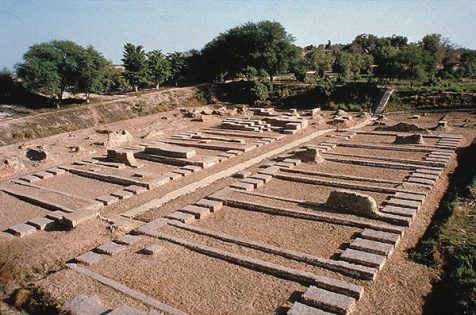
Granary for storing grains from Indus Valley site; Image source: harappa.com.
The gripping narration of Rishi Parashurama killing Kshatriyas and driving the defeated lot out of Aryavartha cannot be simply ignored. Those who were defeated and humiliated had relinquished the Vedic practices, customs in a fit of anger, left India for good and settled in Iran. They were described in Puranas as ‘Parshvas’ later turned in to be called as ‘Parshians’ who were defeated by Parshram. So, the Puranas further describes that they (The Parshvas) reversed every belief of Vedas and formulated their own faith and practices which were just opposite to our main beliefs. Scholars like late Kota Venkatachalam (Books published in1956) and Subhash Kak (Books published in 1990’s) have elaborately discussed these facts. (Though Sri Subash Kak did not fully agree with the story of defeated Pershvas reversing the Vedic Gods).
Here is a list of devas that are included by the Zoroastrians amongst the forces of the good where I provide the corresponding Sanskrit spelling within brackets:
The three great Asuras: Ahura Mazda (Asura Medha) Mithra (Mitra): Also Mihr, together with Raman (Rama) Baga (Bhaga).
Common deities (Yajatas): Apas (Apah): Cosmic Waters; Aban Aradvi (Sarasvati): also Harahvati and the goddess Anahita Airyaman (Aryaman) Asman (Ashman) Atar (Atharvan): Agni Dadar (Data) Gav (Gauh) Ushah (Usha): Dawn Vad (Vata): Wind Vayu (Vayu): Breath Yima (Yama); as in Jam or Jamshed.
Sri Subash Kak’s “Vedic Elements in the Ancient Iranian Religion of Zarathushtra” contains very comprehensive research work on this topic alone. Hence the modern researchers on Harappan sites, cannot and should not ignore this Puranic evidence and in fact, such Puranic evidence would only help them in corroborating the outcome of their study.
The geographical route of Aryan invasion and IVC sites enroute:
Another aspect to support the theory of the reverse expansion of Aryans from Rakhigarhi is the very ‘route’ itself. When Rakhigarhi was dated around 5500 BCE which is near Delhi in Haryana, the Mohenjodaro and Harappan sites which are on the eastern side of India and in Pakistan which were dated 3000 BCE and 1000 BCE, this very factor renders the Aryan invasion theory illogical and indefensible too. When the migration was in progress spanning thousands of years moving from West to East, the approaching sites ahead should be of a later age than the sites that were left behind when advancing towards the East of India.
Despite the clear evidence of some Hindu religious and social practices noticed in Indus Valley Civilization, Witzel dismisses these as not strong enough to prove the continuity of such practices and percolate in to later developed Hinduism.
But if the migration is visualised in reverse direction i.e migration from Rakhigarhi (East of India) to Harappa and further to Iran (West of India) the dating of these sites logically corroborates.
Further Dr VS Shinde had clearly spelt about the religion of the Indus Valley Civilization time. It was peaceful, worshipping Shiva linga, Pashupathi, and the people were well connected with peaceful coexistence throughout the 20 lakh Sq KM are in Arya Vartha.
Sanskrit and Tamil Alphabets
The close similarity of Tamil alphabets to Devanagari cannot just be ignored. This would tell the story differently.
Michael Witzel
Michael Witzel, Wales Professor of Sanskrit, one of the strong exponent of ‘Aryan’ theory, has summarised his observation on the latest findings in Rakhigarhi (proving the nativity of Indus Valley civilization, disproving it’s central Asian origins).
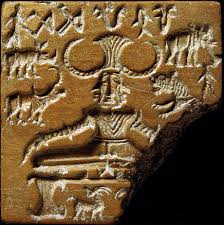
Indus Valley seal of Pashupatinath in Yoga posture; Image Source: Wikipedia.
Wiltze is of the opinion that “the major rupture in civilisation beginning with the immigration of Indo Aryan speaking population around 1200 BC and says ‘only minorcontinuation of Harappan elements in the Vedic period were noticed. This shows that despite the fresh data showing IVC’s nativity and absence of central Asian influence, Wiltze still sticking to the Aryan Invasion theory and trying to disconnect the IVC’s ethnic progression and its influence in the Vedic period. Secondly, he reiterates the time of such ‘Indo Aryan language speaking immigrants interaction with native Indus Valley civilization people in 1200 BCE. So if we were to believe that Gautama Budha ‘s period is around 500 BCE, then the whole Vedic period is to be compressed in just 700 years. That is to say, the 4 Vedas, Aranyakas, Upanishads, Brahmanas, Puranas, Ramayana, Mahabharata and subsequent historical events were all must have happened in just 700 years BCE, just before Gautama Budha or in 600 years before Mahaveer.
Despite the clear evidence of some Hindu religious and social practices noticed in IVC, Witzel dismisses these as not strong enough to prove the continuity of such practices and percolate in to later developed Hinduism.
1) The protection symbol ‘swastika’
2) Pashupatinath in Yoga posture
3) Different Yoga posture terracotta figurines
4) Shiva Linga’s
5) Red parting line in Hindu married woman’s head (Sindhoor)
6) Bhindi.
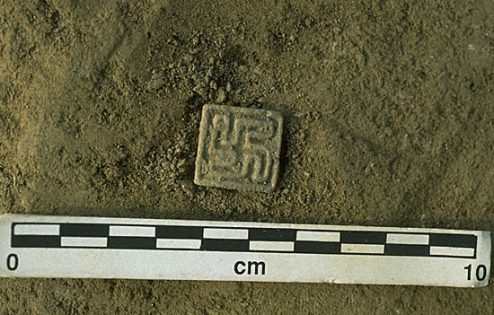
Swastika motif found in Indus Valley (Harappa); Image Source: www.harappa.com
Witzel dismisses the Pashupathi Nath sitting in a Padmasan posture (seal) as a ‘Eurasian deity i.e stone age Lord of the animals. This appears to be a futile contest on his part to detach the Indus Valley civilization from the Vedic age renaissance. He should also explain the Yogic postures, Shiva Linga, and present Hindu practices as listed above.
The other most astonishing evidence is Shiva Linga. But this evidence has been neatly bypassed and no explanation is forthcoming from Witzel. However, I have my own suspicion that this Shiva worship continued in IVC and later penetrated into Northern Karnataka.
If we examine closely some later year artefacts and female figurines, we can notice the woman sporting a Bhindu and the forehead lashed with 3 line marks. Like the present day, Veera Shaivaits lash their foreheads with Vibhuthi.
Although, the Pashupatinath in Yoga posture (seal) was the early manifestation of Lord Shiva as some Shiv Linga artefacts too found from the same site. That may appear to be the very rudimentary form of Hinduism for our eyes but no regrets; it was certainly with a cosmic understanding of the secrets of creation which paved the way in later days for Trinity Cosmic concept. Alas, such a Dharma called Hinduism survived to date, maybe there were no messengers sent by the God into that peaceful society to brainwash the clan, by writing single-holy-books, thereby destroying the very evolving mankind in the valley of Ganga, Yamuna and Saraswathi at the buds.
In the meantime, another research work says Paleo-Rivers Predated Harappans by 35,000 Years? (Paleo-Rivers Predated Harappans By 35,000 Years).
Note: Text in bold within brackets are additional data on the topic.
Featured image courtesy: Wikipedia, harappa.com and BBC.
This article was first published in pgurus.com.
Disclaimer: The views expressed here are solely of the author. My India My Glory does not assume any responsibility for the validity or information shared in this article by the author.

